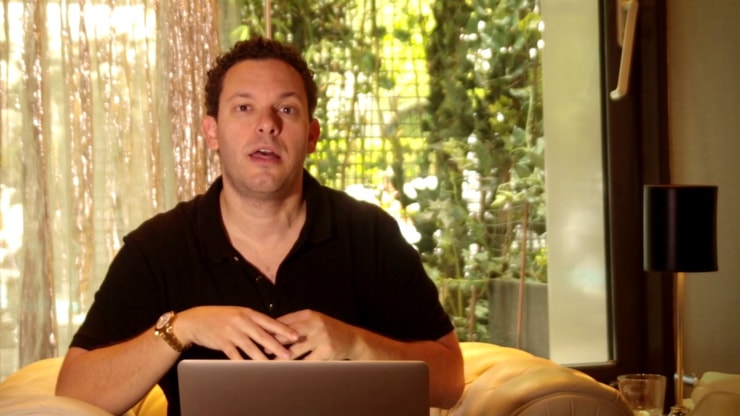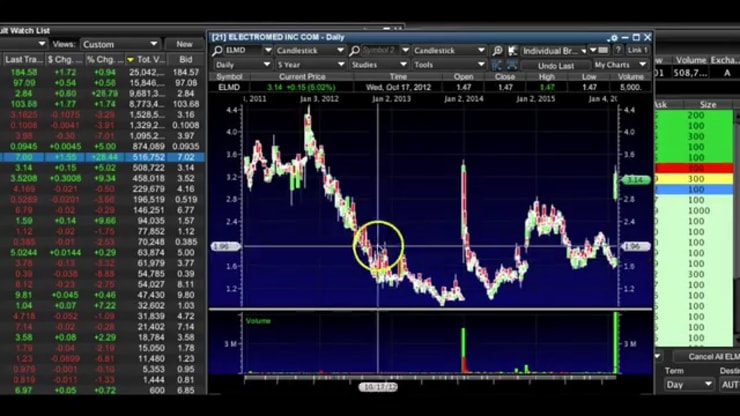New traders almost always look for ways to improve their trading, but knowing common trading mistakes is just as important.
No trader has a perfect trading record. You will make mistakes and you will lose sometimes. But that doesn’t mean you can’t learn from traders who have experience…
And it definitely doesn’t mean you can’t learn from your own slip-ups.
I’ve compiled this list of 10 common trading mistakes, so you can learn to avoid them and trade smarter.
Throughout your trading journey, refer back to this list often to make sure you don’t fall back into these traps.
Table of Contents
- 1 #1 Relying on Hot Stock Picks
- 2 #2 Having the Wrong Mindset
- 3 #3 Being Unprepared
- 4 #4 Using the Wrong Broker
- 5 #5 Trading the Wrong Stocks
- 6 #6 Lack of Self-Discipline
- 7 #7: Forcing Trades
- 8 #8: Trying to Guess or Anticipate Earnings
- 9 #9 Confusing Investing with Trading
- 10 #10: Going It Alone
- 11 The Bottom Line
#1 Relying on Hot Stock Picks
One of the biggest mistakes most new traders make is thinking they can get rich by following other people’s trades and stock picks.
Too many traders don’t want to study or work hard. Instead, they say things like, “Hey Tim, give me a hot stock pick … just tell me which one to buy.”
Sorry, it doesn’t work that way. You should NEVER follow anyone’s stock picks or trades…
You need to learn market skills for yourself. You can’t rely on someone else. The reality is, this industry is full of fakes. So many traders claim to be successful but really have no idea what they’re doing.
Don’t blindly follow others. Instead, learn from traders who have a transparent track record and who can teach you how to develop your own trading strategy.
I teach my Trading Challenge students to be self-sufficient. They learn to adapt to the market and think for themselves. They don’t need to rely on someone else to tell them what to buy and how to trade.
#2 Having the Wrong Mindset
If you got into trading because you think it’s a ticket to get rich quick … or if you only think about the money when you’re in a trade … then you have the wrong mindset.
The ‘get rich quick’ mentality will affect your ability to execute and manage trades — and not in a good way.
When you’re in a trade, you should focus on the reasons you’re in the trade … your thesis, the indicators, managing your entry and exit. Don’t focus on the profits.
If you want to be in this game long term, you need the right mindset. And that isn’t getting rich quick. Your goal should be to hit singles, not home runs.
#3 Being Unprepared
Traders who want hot stock picks and ‘home-run’ trades aren’t prepared for the market. They’re not prepared mentally to manage risk and react to the many scenarios that are possible when you’re in a trade.
How to help prepare? Study the past before putting your hard-earned money on the line in any trade.
It takes time and dedication to study, but you must be willing to learn the patterns, practice and refine your strategies over time, and continually adapt to the markets.
It’s a marathon, not a sprint. Take your education seriously so you can be prepared for those awesome setups when they present themselves.
There’s so much free education on the internet, you have no excuse not to study!
#4 Using the Wrong Broker
A lot of new traders start with the cheapest broker they can find. They think saving a small amount on commissions will increase their income. But the thing is, using the wrong broker can actually cost you more.
Cheap brokers can screw you over with bad executions, poor service, no tools, or worse…
When it comes to brokers, you need speed. When you want to buy a stock for a specific price, you need quick executions, especially when the stock is moving fast. And if you’re in a trade and need to get out fast, bad executions and lagging data can hang you out to dry.
Make sure you choose the right broker for your strategy. If you short penny stocks, you need a broker that has shares available to short. Brokers usually charge locate fees for you to borrow shares, so be careful and do your research. Make sure there’s still room for profits after all the fees.
Penny stocks can move fast. Use the tools and brokers that can help you keep up.
#5 Trading the Wrong Stocks
Sometimes new traders think they see a pattern on a chart and jump in without considering any other indicators, such as volume, catalysts, and volatility.
If you jump into trades without doing your research, you’re not trading — you’re just gambling. You don’t know if it will go up, down, or sideways.
Worse, you can get stuck in your position or be forced to sell for a way lower price just to get out. There has to be volume in the stock so you can easily get in and out of your positions.
Learn to focus on the biggest percent gainers for the day, with lots of volume and preferably a catalyst. Want to learn more about it? Here are some great no-cost resources for traders.
#6 Lack of Self-Discipline
People with no self-control and poor discipline will struggle in the markets. If you can’t follow the rules and control your actions and emotions, there’s little room for improvement.
I teach my trading rules that have brought me success, but you have to have the self-discipline to follow them.
Remember to Cut Losses Quickly
My number-one trading rule is to cut losses quickly. When you’re in a trade and it goes against you, you need to get out!
If you’re down on your position and you don’t cut your loss, you risk the money in the trade … but you also risk your probability of staying in the game. If you take losses that are too large, you can blow up your account fast.
Learn to take small losses and review every trade. Learn to manage your risk. Never hold and hope.
Don’t Chase
So you see a stock spiking and you’ve gotta get in at any cost, right? Wrong! This is a classic newbie mistake. Don’t chase stocks. You risk buying at the top and having to chase it down to get out.
Poor entries can affect your entire trading mentality. It can affect how comfortable you are in a trade. If you miss your entry, it’s OK to miss the trade.
Learn to build and stick to your trading plans. It can make it so much easier to keep the big picture in mind. You can better learn to stick to your entry and exits. You did the research, so you have better expectations of what might happen.
But if you chase a stock and get in at any cost, then what? What’s your risk? What’s your goal?
Learn to be meticulous when you plan your trades and remember that you need discipline to stick to your plan.
#7: Forcing Trades
When you see a pattern setting up, you’re probably looking forward to the trade. You’re anticipating what the stock might do … you want to jump in and nail it.
But careful … don’t force the trade. Patience is key when you plan your entries. You need to wait for the best possible opportunity to buy.
Be sure to focus on your patterns and fine-tune your timing. Trade to your patience level and do what feels comfortable to you. Don’t rush into a trade you don’t have a plan for and don’t try to buy early, thinking you know what the stock will do.
When you don’t wait for the best plays, it drains your mental capital and can impact your ability to execute the next time you try to trade.
Hey, even I still do it sometimes. Here’s a great example of how I still learn from trades, even after over 20 years in the markets.
#8: Trying to Guess or Anticipate Earnings
Anticipating or trying to guess what a stock’s reaction to earnings will be, is exactly that — a guessing game. It’s not a strategy. I always wait for price action to show me how the market’s reacting.
An example that comes to mind is this trade from back in November:
Roughly $3,000 in profits for me on MITK all because I employed my favorite pattern of dip buying earnings winners, as long as they hold technical support…I now have 600+ videos HERE on earnings winners, I suggest you learn this pattern ASAP!
Some traders will say, “But Tim, this company had really good revenue this year. I’m just going to buy pre-market while the price is still low.”
But then when the market opens they watch it tank because they didn’t know as much as they thought they did.
I want the chart pattern to show me whether it’s an earnings winner or loser. I don’t guess earnings ahead of time — I wait for the price action to indicate whether there is potential in the stock.
#9 Confusing Investing with Trading
When traders confuse investing with trading, they buy a penny stock to hold it long term. They hold and hope — thinking the price will continue to go up.
Maybe they base that on the company’s technology or products. Maybe they just like the company. (Here’s why what you think of a company doesn’t matter in trading.)
Bottom line: You can’t evaluate a penny stock the same way you would a large-cap company. Here’s the deal with investing vs. trading…
More Breaking News
- Analyzing NEGG’s Surge: Time to Act?
- Avino Silver & Gold Mines Ltd. announces equity program renewal amid market shifts
- Futu Stock Surges: A Perfect Storm?
Investing
Investors buy stocks to hold them long term. They believe in a company’s fundamentals, such as earnings, products and income, and the company’s management.
This can involve holding on to the stock for weeks, months, or years.
Penny stocks aren’t like that. Most of these companies are junk. A lot of them only have one or two products. Most of them will eventually go bankrupt.
I do NOT invest in penny stocks! I trade this niche with specific setups. I’m not investing to hold the stock long term. Remember, most of these companies will fail.
Trading
Day trading is when you execute a trade — a buy and a sell — in one day. Some traders execute multiple day trades per day.
I day trade penny stocks. I’m usually in and out of stocks quickly, sometimes in minutes. If the right setup presents itself, I may hold overnight, anticipating a gap-up the next morning.
I trade based on patterns and news. I plan my trades. And I only trade the best setups.
An important thing to note: you need to understand the pattern day-trader rule (PDT). The PDT set restrictions on the number of day trades you can execute per week if you trade with a small account.
Still confused about the difference between investing and day trading? Check out this free webinar where I go into more detail about the stock market, my strategy, and my mindset.
#10: Going It Alone
A lot of new traders struggle for a long time on their own trying to figure out the stock market.
There’s no reason to struggle and lose tons of money. But you’ve gotta invest in your education.
There are so many online resources. Use my YouTube channel. Take my free PennyStocking 101 course. Get a mentor.
Having a mentor can help you speed up your learning curve. Learn from experienced and transparent traders. I never had a mentor, and that’s why I teach now. I want to be the mentor I never had to my students.
There are so many opportunities in the stock market. Learn as much as you can from successful traders — their mistakes and wins. Work to find the strategies and setups that make sense to you. You don’t have to figure it all out on your own.
The Bottom Line
One final important note: All traders make mistakes. Nobody’s perfect. You won’t be right 100% of the time.
You need to accept that being wrong is part of trading. Even after 20+ years in the markets, I still mess up trades … You can see all my trades on Profit.ly — wins and losses. Plus, there are over 6,000 videos to help you learn the markets.
So yeah, you’ll lose sometimes. And that’s OK, especially if you follow rule #1 and cut losses quickly.
Be disciplined and continually work to improve. That’s one way to help cut down on your mistakes. And when you do make mistakes, make sure they’re small. Never take big risks that can knock you out of the game for good.
Ready to be a smarter, self-sufficient trader? Apply for my Trading Challenge today.
What’s the biggest trading mistake you’ve made and what did you learn from it? I love to hear from you … Leave a comment!
















Leave a reply